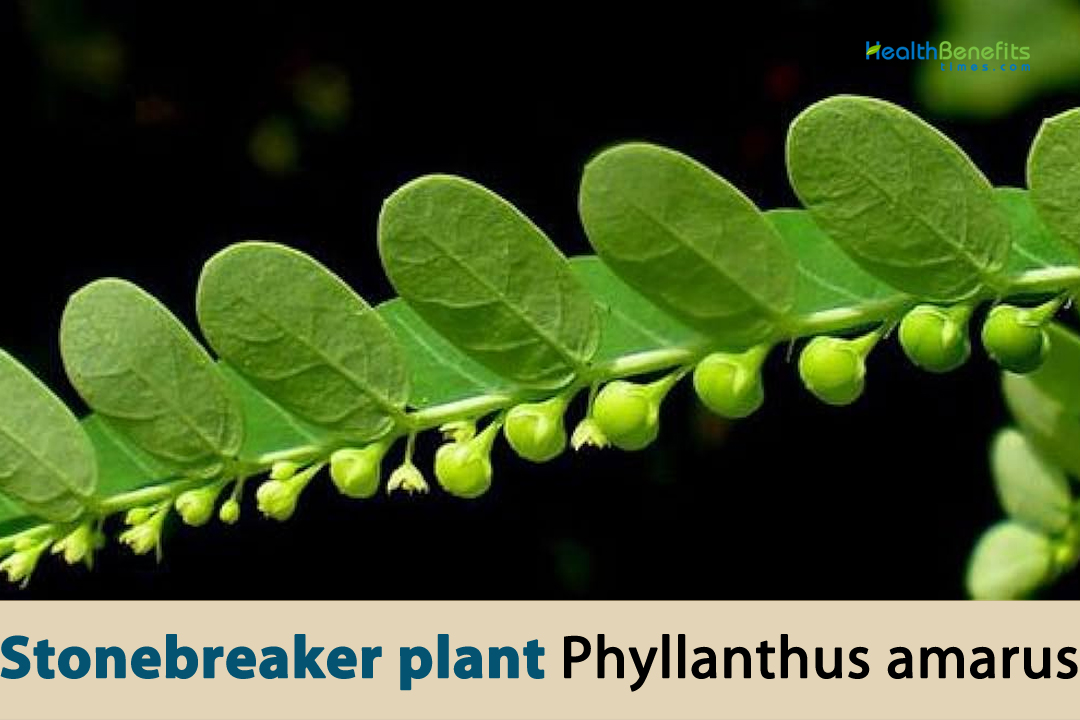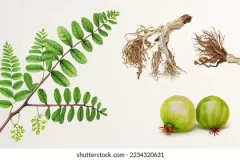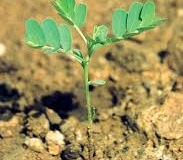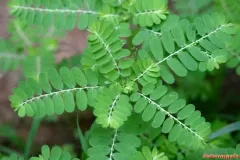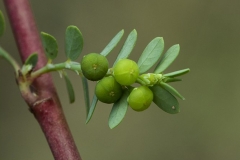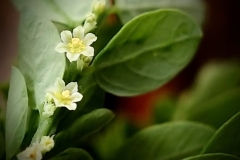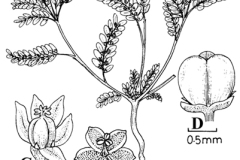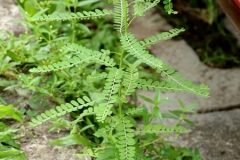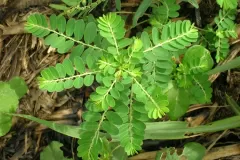| Stonebreaker plant Quick Facts | |
|---|---|
| Name: | Stonebreaker plant |
| Scientific Name: | Phyllanthus amarus |
| Origin | tropical and subtropical regions around the world including various countries in South America, Africa, India, China, Sri Lanka and South East Asia |
| Colors | Initially green turning to pale or light brown color |
| Shapes | Small dry, globular, smooth dehiscent capsules about 2 mm in diameter |
| Taste | Slightly bitter and astringent |
| Major nutrients | • Alkaloids • Flavonoids • Tannins • Lignans • Phenolic Compounds • Terpenoids • Saponins |
| Health benefits | Kidney Stone Dissolution, Liver Health, Gallstone Relief, Urinary Tract Infections (UTIs), Blood Sugar Control, Blood Pressure Regulation, Gallbladder Health, Respiratory Health, Cardiovascular Health, Wound Healing, Support for Hepatitis |
| Name | Stonebreaker plant |
|---|---|
| Scientific Name | Phyllanthus amarus |
| Native | Tropical and subtropical regions around the world including various countries in South America, Africa, India, China, Sri Lanka and South East Asia |
| Common Names | Kidney Stone Crusher, Gale of the Wind, Creole Senna, Seed-Under-Leaf, Carry-Me-Seed, Stone Breaker Plant, Shatter stone, Bhumyamalaki |
| Name in Other Languages | Afrikaans: Klipbreek Amharic: Ye-mesale Hareṛit (የምሳሌ ሀረሪት) Arabic: Kassarat Alhajar (كسارة الحجر), Nabat Taksir Alhajar (نبات تكسير الحجر) Armenian: K’ari ktrich (Քարի կտրիչ) Assamese: Bhuin Amla Bengali: Bhui Amla (ভুই আমলা), Phoshalita (ফসলিতা), Bhumamla, Bhumi amalaki Bulgarian: Kamenolomka (Каменоломка) Burmese: Kyat Phru: Si (ကျပ်ဖြူးစေ), Kyat Phru (ကျပ်ဖြူး) Chichewa: Mphalapala Chinese: Záo Shí Cǎo (凿石草), Xia Ku Cao (Summer Weed), Suìshí cǎo (碎石草), Xiǎo fǎn hún (小返魂), Kǔwèi yè xià zhū (苦味叶下珠), Gekka tama (月下珠), Bà bèi cài (霸贝菜) Croatian: Kamenolomka Czech: Kamenolomka Danish: Stenknuser Dutch: Steenbreker English: Stonebreaker, Chanca Piedra, Kidney Stone Crusher, Shatterstone, Carry me seed, Demerara Tamarind, Bitter Root, Gale-of-wind, Seed Under Leaf, Wild Tamarind, Black catnip, Child pick-a-back, Gulf leaf flower, Hurricane weed, carry-me-seed, Jamaica weed, pick a back, seed on the leaf, Country gooseberry Estonian: Kivipurustaja Fijian: Ivi Wai Filipino: Pitirishi Finnish: Kivenmurskaaja French: Casse-Pierre, Poudre de plomb Fulfulde: Ŋamjaŋam German: Steinbrecher, Bittere Blattblüte, Weisse Blatt-blume Greek: Fyto Katalytikou (Φυτό Καταλυτικού), Kontosfyri (Κοντοσφύρι) Gujarati: Bhuiyan Aavli (બૂઇઆં આંવળી), Bhoi Amali, Bhony amari, Bhonyamali Hausa: Gaskiya Hawaiian: Pohakuhuluhulu Hebrew: Tzimach Minafetz Evenim (צמח מנפץ אבנים), Mefatzel Avanim (מְפַצֵּל אֲבָנִים) Hindi: Bhumi Amla, Bhui aonla, Jaramla, Jangli amli, hajarmani, Bhui aonla (भूई आंवला), Jaramla (जड़ आमला), Jangli amli (जंगली अमली), Hazardana, Jaramala, Bhui amla Hungarian: Kövirózsa Icelandic: Steinknútur Igbo: Ntu nsi Indonesian: Meniran, Pecah Batu, dukung anak Italian: Rompepietra, Spezzapiedi, Pianta delle pietre Japanese: Yari Hachisu, Ishi Kudaki no Shokubutsu (石砕きの植物), Ishi o kudaku kusa (石を砕く草), Kidachi komi kansou (キダチコミカンソウ) Kannada: Hallina Boovina Gani (ಹಲ್ಲಿನ ಬೂವಿನ ಗಣಿ), Nelanelli, Kiru Nelli (ಕಿರುನೆಲ್ಲಿ) Kashmiri: Kath Khmer: Kbaachey Kyaong (ក្បាចេះខ្យង់) Kinyarwanda: Ubutaka Korean: Dol-ggaebi-pul (돌깨비풀) Lao: Seepin (ເສີພິນ) Lithuanian: Akmenkirtis Latvian: Akmeņu lauztājs Luganda: Ekibuulire Malagasy: Vovonana Malay: Batu Pecah Malayalam: Nela Usiri, Patharati (പത്തരടി), Keezhanelli, Keezharnelli, Kiruthaanelli, Kizhaanelli, Kizhar Nelli, Kizhukanelli, Kilanelli Manipuri: Chakpa heikru (ꯆꯛꯄꯥ ꯍꯩꯀ꯭ꯔꯨ) Maori: Rahurahu Marathi: Phadkata (फडकता), Bhuiavali (भुईआवळी), Bhuiawali Nepali: Pathar Todne Bota (पाथर तोड्ने बोट) Norwegian: Steinbryter Oriya: Bhuin Amla Oromo: Dabalataa Persian: Kuh-Kandak (کوهکندک) Polish: Rozłupywacz kamieni Portuguese: Quebra Pedra, Erva-pombinha Punjabi: Keeapatar (ਕੀਆ ਪਤਰ), Fika Patra (ਫਿਕਾ ਪਤਰ), Lodhar Romanian: Spărgătorul de pietre Russian: Razbivatel’ kamney (Разбиватель камней) Samoan: Vao faaʻititi ma vaa Sanskrit: Bhumyaamalaki, Bhumyaamlaki, Jar amla, Jaramala, Thamalaki, bahupatra, Bahupatra (बहुपत्र), Bhumyaamalaki (भूम्यामलकी), Bhuamlaki, Bahupatri Serbian: Lomach kamenac (Ломач каменац) Sesotho: Mafuba Sinhala: Kalunu Kumu (කලුණු කුමු), Kumudula (කෘමුදුල) Slovak: Kamenolomka Slovenian: Kamenolomka Somali: Geed Qoxo-Qoxo Spanish: Chanca Piedra, Yerba mágica, hierba de la niña, quinino Swahili: Kivunja Jiwe, Mimea ya Kuvunja Mawe Swazi: Ilitsatsi Swedish: Stenbrytare Tagalog: Bato-bato Tamil: Kalli Seeragam (கல்லி சீரகம்), keelanelli (கீழாநெல்லி), kizkaynelli (கீழ்காய்நெல்லி), Kizhukai nelli, Kizanelli Telugu: Nalla Usiri, nela usiri (నేల ఉసిరి), Nela usirika Thai: Tamalam Khon, Hin Thap (หินทับ), Khong Leow Ku (ของเหลวกู), Hin Tamruat (หินตำรวจ) Tibetan: Gzig Bwang Kha (གཟིག་བང་ཁ) Tswana: Tshekatsheko Turkish: Taş Kırıcı Bitki, Taş Kırıcı Ot Ukrainian: Rozkam’yanyuvach (Розкам’янювач) Urdu: Pathar Churan Wali (پتھر چُران والی) Vietnamese: Cỏ Lôi, Rễ lược đặc, Diệp hạ châu đắng, Chó đẻ thân xanh Wolof: Jaxas Xhosa: Ihlaba Yoruba: Owonjona Zulu: Isikhukhula |
| Plant Growth Habit | Erect, small low-growing, annual herbaceous plant |
| Growing Climates | Villages, gardens, cultivated fields, open localities, waste ground, grassy scrub vegetation, dry deciduous forest, dry fields, roadsides, forest margin, scrubby woods, lawns, scrublands, moist localities, degraded moist deciduous, forest plantations |
| Soil | Needs well drained soil and thrive in sandy, loamy, and stony soils |
| Plant Size | About 30 to 50 centimeters (12 to 20 inches) tall but usually less than 30 cm |
| Root | Relatively small and thin fibrous root system originating from the base of the stem |
| Stem | Upright somewhat sprawling or prostrate, soft, green not woody stem |
| Bark | Does not have a traditional woody bark like trees or shrubs |
| Leaf | Small, elliptical to obovate (inverted egg-shaped) about 5-10 mm in length, bright green and often have a glossy appearance. Margins are typically smooth, without serrations or teeth |
| Flowering season | March to August |
| Flower | Very small, urn-shaped or bell-shaped, greenish-yellow to yellowish-green colored. The flowers may be solitary or clustered in the leaf axils along the stem |
| Fruit Shape & Size | Small dry, globular, smooth dehiscent capsules about 2 mm in diameter, which appears on the underside of the branches |
| Fruit Color | Initially green turning to pale or light brown color |
| Fruit Skin | Usually smooth and somewhat translucent when they are green |
| Fruit Weight | Only a fraction of a gram |
| Seed | Small, usually spherical or somewhat flattened about 1 to 2 mm in diameter, typically brown or black colored |
| Flavor/Aroma | Mild, earthy, or herbal scent when crushed |
| Taste | Slightly bitter and astringent |
| Plant Parts Used | Leaves, Stem and Roots |
| Propagation | By seed, stem cutting, Division and Air layering |
| Lifespan | Within one year or a few years |
| Varieties |
|
| Major Nutrition |
|
| Available Forms |
|
| Health benefits |
|
Plant Description
Stonebreaker plant is an erect, small low-growing, annual herbaceous plant that typically reaches a height of about 10 to 30 cm (4 to 12 inches) and has a spreading, low-growing habit. Despite minor variations in size due to age and growing conditions, this herbaceous plant is generally regarded as a compact specimen that thrives in a variety of landscapes and gardens. In numerous cultures, the plant has a lengthy history of traditional medicinal use. Primarily, it is recognized for its potential to aid in the management of kidney stones and the promotion of urinary tract health. It has been employed in traditional herbal medicine to facilitate the passage of kidney stones and aid in their disintegration. In some regions, it is utilized as an enhancing agent or seasoning in culinary dishes. Occasionally, it is also swallowed as a tea.
Herbal preparations and supplements containing Phyllanthus amarus are frequently marketed online and in health food stores as having potential benefits for the kidneys and liver. There is no status of the plant as endangered or imperiled. In its native regions, it is a relatively prevalent plant that is occasionally regarded as a weed. Although it is generally regarded as secure, not all individuals may find it appropriate. It is advisable for pregnant or nursing women, individuals with specific medical conditions, and those taking particular medications to exercise prudence and consult with a physician prior to utilizing herbal remedies.
Appropriate growing environment for Stonebreaker plant
Stonebreaker plant is a hardy herbaceous plant that can thrive in various growing environments, but it typically prefers warm and tropical to subtropical conditions. Here are the key factors to consider when providing an appropriate growing environment for the Stonebreaker plant:
- Climate: Stonebreaker plants favor tropical and humid environments. They flourish in environments ranging from 70°F to 95°F (21°C to 35°C) in temperature. However, they can tolerate brief periods of slightly lower temperatures.
- Sunlight: Generally, stonebreaker plants thrive in direct to partial sunlight. Although they thrive in well-lit areas, they can also survive in partial shade. They frequently inhabit the understory of tropical forests.
- Soil: Soil with adequate drainage is critical for Stonebreaker vegetation. They have the ability to thrive in sandy, loamy, and stony soils, among others. They are, however, intolerant of soils that are flooded or have poor drainage.
- pH Level: In general, stonebreaker plants favor neutral to slightly acidic soil between 6.0 and 7.0 pH.
- Watering: Although Stonebreaker plants can withstand adverse conditions once they have become established, consistent moisture is crucial, particularly throughout the growing season. Aim to water the soil regularly, without overdosing it, and permit a brief period of drying between each irrigation session.
- Propagation: Plants of the stonebreaker variety are propagable via cuttings or spores. While seeds and cuttings may be rooted in appropriate growing mediums, they may be distributed directly into the garden or in potting mix that has adequate drainage.
- Fertilization: In general, stonebreaker plants do not necessitate substantial fertilization. Throughout the growing season, use a balanced, slow-release fertilizer judiciously; however, do not over-fertilize, as this can result in an overabundance of foliage with fewer medicinal compounds.
- Container Growing: When cultivating Stonebreaker in containers, use a potting mix that drains well and ensure that the receptacles have adequate drainage. If cultivating indoors, position the containers in a sunny location or supplement the illumination.
- Pruning: By pruning the plant on a regular basis, its form can be preserved and bushier growth promoted. By pinching the ends of young shoots, branching can be encouraged.
- Pests and Diseases: Stonebreaker plants have a moderate resistance to diseases and parasites. Nonetheless, keep an eye out for prevalent pests such as mealy bugs and aphids, and take the necessary precautions.
Roots
Originating at the base of the stem, stonebreaker plants typically have a fibrous root system characterized by relatively small and slender roots. These roots form a network of fine roots by spreading out in various directions. The roots frequently extrude in a wide array. The process of branching facilitates the plant’s efficient uptake of nutrients and water from the soil. Branches of varying complexity may be observed in plants of varying ages and states of health. Stonebreaker, similar to the majority of plants, possesses minuscule root filaments that augment the surface area available for the absorption of water and nutrients. Feeder roots, which are finer in texture, contain these root filaments.
Although Stonebreaker plants have a fibrous and sparse primary root system, they may develop a taproot during their youth. The taproot serves to stabilize the plant in the soil by developing vertically downward. Nevertheless, as the plant reaches maturity, the prominence of the taproot typically diminishes in contrast to the fibrous root system. Typically, the roots are pale in hue, frequently appearing translucent or light brown. They initially possess a relatively silky texture, but as they age, that texture may become rougher.
Stem
As a perennial plant, Stonebreaker lacks secondary growth and its stem is devoid of woody structure, distinguishing it from trees and shrubs. Conversely, it maintains a gentle, green hue throughout its existence. Although the Stonebreaker plant generally exhibits an erect growth habit, it is capable of developing a sprawling or prostrate growth style under certain circumstances, such as light competition or environmental influences. Generally speaking, the stem is green and relatively smooth. While possessing a few delicate, short filaments or minor ridges, it does not exhibit the coarse, bark-like texture typical of woody stems. Branched stems are a common characteristic of stonebreaker plants, particularly as they mature. The number and configuration of branches that emerge from leaf axils (the angle between the leaf and the stem) may differ based on the age and growing conditions of the plant.
Bark
The Stonebreaker plant is classified as an herbaceous plant, deviating from the conventional woody bark found on trees and shrubbery. In contrast, its stem is delicate and green, devoid of any solid bark tissue. Consequently, it lacks the characteristic bark structure observed in arboreal organisms.
Leaves
Alternation of leaves is observed along the stem. This implies that instead of being positioned directly opposite one another, the attachment point of each leaf along the stem differs. Typically, the leaves range in shape from elliptical to obovate, resembling an inverted egg. While their dimensions may differ, they are typically on the shorter side, measuring between 5 and 10 mm in length. Smooth leaf margins devoid of serrations or canines are the norm. A basic, entire (smooth) margin characterizes them. Pinnate venation refers to the arrangement of veins on the foliage; it resembles feathers and consists of a central midrib from which smaller veins emanate. Veins are typically not noticeable.
Generally speaking, the leaves are lustrous or waxy in appearance and are smooth. While the leaf surface may exhibit a faintly elevated or veined appearance, it does not possess an excessively textured surface. Generally, the leaves are a brilliant shade of green; however, this can differ slightly with the plant’s age and environmental conditions. A petiole, a diminutive limb that joins the leaf blade to the stem, serves to connect each leaf to the stem. Petioles are comparatively brief. In general, the leaf apex (tip) is pointed, whereas the base, where it joins the petiole, is attenuated or rounded.
Flowers
Stonebreaker flowers are typically quite diminutive, with a diameter of mere millimeters. They are frequently characterized as bell-shaped or urn-shaped. Stonebreaker flowers are typically yellowish-green or greenish-yellow in hue. Frequently green or yellow-green in color, the petals may have a translucent quality. Five green sepals comprise each flower; they enclose the flower blossom prior to its opening. Frequently, the petals are pointed and slender, lending the flowers their distinctive form. Petal fusion occurs at the root of male flowers, resulting in the formation of a cup-like structure. Generally speaking, the petals of female blossoms are more distinct. Male flowers typically contain five or more stamens, which are the reproductive structures of males. The pollen is produced by these stamens. The sole pistil, which constitutes the female reproductive structure, is present in female blossoms. The pistil is composed of the stigma, an ovary, and a style. Situated apex of the pistil, the ovary harbors the ovules, which are progeny of seeds. Pollen must rest on the stigma, which is located at the apex of the pistil, in order for fertilization to be successful.
Fruits
The fruits consist of dehiscent, desiccated capsules. The term “dehiscent” refers to the process by which mature seeds split open. The containers are predominantly quite diminutive, with a diameter of merely a few millimeters. The shape of the capsules is typically spherical or globular. The capsules are green when they are embryonic; as they develop, they may become pale or light brown in hue. When the capsules are green, their surface is typically smooth and may appear translucent to some degree. Capsules generally comprise multiple chambers or compartments, with one or more seeds contained within each.
Seeds
The diameter of stonebreaker seeds is typically between one and two millimeters. In general, the seeds have a spherical or slightly flattened, elliptical, or round morphology. Typically, seeds have a brown or black hue. The seeds might possess a marginally reflective or sleek exterior. Every seed is protected by a resilient seed sheath or outer covering. The seed is protected by means of this seed coat.
Varieties of Stonebreaker plant
Stonebreaker is a plant species that is known for its potential medicinal properties, especially in traditional herbal medicine. While there may not be numerous recognized botanical varieties of Stonebreaker plant in the same way as cultivated crops, there can be regional variations in its appearance and properties based on environmental conditions and geographic locations. Here are a few regional variations or adaptations of Stonebreaker plant
- Phyllanthus amarus var. niruri: Frequent synonymy exists between this variety and the species Phyllanthus niruri. It is distinguished by its elliptical, green, and diminutive foliage and is renowned for its conventional application in botanical medicine.
- Phyllanthus amarus var. urinaria: Numerous characteristics of this closely related species, also known as Phyllanthus urinaria, are shared with Phyllanthus amarus. It is frequently employed synonymously in the context of traditional herbal medicine.
Health benefits of Stonebreaker plant
Stonebreaker is a medicinal plant that has been used for its health benefits in various traditional medicine systems, particularly in Ayurveda and traditional South American folk medicine. It is native to tropical regions and is renowned for its potential therapeutic properties. Here are detailed health benefits associated with Stonebreaker plant:
1. Kidney Stone Dissolution
A widely recognized application of the Stonebreaker plant is its capacity to facilitate the dissolution of kidney stones. Bioactive compounds present in it potentially induce muscular relaxation in the urinary tract, thereby facilitating the passage of small stones and the fragmentation of larger stones into more manageable pieces.
2. Liver Health
The hepato protective properties of the stonebreaker plant indicate that it can shield the liver from a variety of toxins and injury. It potentially facilitates liver detoxification, function enhancement, and health promotion.
3. Gallstone Relief
Comparable to its impact on kidney stones, the Stonebreaker plant potentially aids in the disintegration or expulsion of gallstones, thereby conferring advantages to individuals afflicted with gallbladder dysfunction.
4. Anti-Inflammatory
The anti-inflammatory properties of the plant may prove beneficial in the treatment of inflammatory conditions, including arthritis, gout, and inflammatory bowel diseases.
5. Antioxidant Activity
An abundance of antioxidants in the stonebreaker plant enable it to combat detrimental free radicals within the body. This antioxidant activity may reduce the risk of chronic diseases and benefit overall health.
6. Urinary Tract Infections (UTIs)
Stonebreaker plant may increase urine secretion as a result of its diuretic properties, thereby potentially aiding in the elimination of toxins and bacteria from the urinary tract. This may be beneficial for the prevention or treatment of UTIs.
7. Antiviral Properties
Some studies suggest that Stonebreaker plant has antiviral activity against certain viruses, making it a potential candidate for the treatment of viral infections.
8. Digestive Health
The Stonebreaker plant has been utilized historically to treat digestive issues including dysentery, diarrhea, and indigestion. It potentially exerts a calming influence on the digestive system and mitigates symptoms of gastrointestinal distress.
9. Blood Sugar Control
Some evidence suggests that the Stonebreaker plant may assist in regulating blood sugar levels, making it a potentially advantageous substance for diabetics and those at risk of developing the disease.
10. Blood Pressure Regulation
Historically, the stonebreaker plant has been utilized to assist in blood pressure management, thereby potentially enhancing cardiovascular well-being.
11. Anticancer Potential
Anticancer properties of the Stonebreaker plant may be present, according to some research, specifically in inhibiting the proliferation of particular types of cancer cells. However, additional research is required to validate these effects and elucidate the underlying mechanisms.
12. Gallbladder Health
Stonebreaker potentially promotes gallbladder health through its ability to inhibit gallstone formation and enhance biliary flow. Additionally, it may ameliorate gallbladder discomfort and reduce the likelihood of complications associated with gallstones.
13. Detoxification
This plant is regarded as an all-natural detoxifier. It facilitates the elimination of hazardous substances and toxins from the body, thereby promoting overall health.
14. Respiratory Health
Stonebreaker has historically been employed for the purpose of mitigating respiratory ailments, including asthma, bronchitis, and coughs. It may aid in bronchial muscle relaxation and airway inflammation reduction.
15. Anticancer Properties
Although further investigation is warranted, preliminary research has indicated that Stonebreaker might have anti-cancer properties. Its potential to reduce the risk of cancer development and inhibit the proliferation of specific cancer cells has been the subject of research.
16. Cardiovascular Health
Potential cardiovascular benefits of Stonebreaker include a reduction in cholesterol levels and an enhancement of blood circulation. These effects have the potential to mitigate the risk of cardiovascular diseases.
17. Antispasmodic Effects
The plant has the potential to function as an inherent analgesic and muscle relaxant. It can alleviate cramping and spasms of muscles throughout the body.
18. Wound Healing
Stonebreaker has been applied topically to promote wound healing in some cultures. Antibacterial and anti-inflammatory properties may aid in the prevention of infection, reduction of edema, and acceleration of the healing process, respectively.
19. Antipyretic (Fever-Reducing) Properties
Throughout history, Stonebreaker has been employed to alleviate fever. It has the potential to assist in reducing body temperature in cases of fever or heat-related ailments.
20. Support for Hepatitis
Research has demonstrated the potential of Stonebreaker to provide assistance to individuals afflicted with hepatitis. It has the potential to ameliorate liver function and decrease inflammation in individuals afflicted with hepatitis.
21. Antifungal Activity
Stonebreaker has been investigated as a potential natural remedy for fungal infections, including those that impact the skin and nails, due to its possible antifungal properties.
Traditional uses of Stonebreaker plant
- The stonebreaker plant, also known as Bhui amla, has been historically employed in the treatment of numerous ailments.
- When taken orally, the heated water extract of the entire plant has a laxative and fever-reducing effect.
- The decoction demonstrates efficacy in reducing fever as well.
- The entire plant is desiccated and pulverized to obtain a powder that is mixed with buttermilk for the treatment of jaundice.
- In the event of loose motions, an infusion of desiccated leaves is administered for dysentery.
- A lukewarm water extract is beneficial for diabetes.
- Fresh root or leaf fluid is consumed orally to treat sexually transmitted diseases (STDs).
- Externally, the plant is also utilized.
- In order to treat cuts, bruises, and skin diseases, the leaf juice is applied topically to the afflicted area.
- External application of the fruit treats tubercular ulcers, dermatitis, and ringworm.
Culinary uses of Stonebreaker plant
Stonebreaker plant is primarily known for its medicinal properties, but it is not commonly used in culinary applications. However, in some cultures, it has been used in traditional recipes for its purported health benefits. Here are a few ways in which Stonebreaker plant has been used in culinary practices:
- Herbal Teas: Stems and leaves of stonebreaker may be incorporated into botanical teas. For the preparation of a tea, hot water can be used to steep fresh or desiccated Stonebreaker leaves. There are individuals who combine it with additional botanicals or teas in order to enhance its flavor. There are rumors that the tea may possess health benefits, specifically in relation to the urinary tract and kidneys.
- Condiments and Seasonings: Stonebreaker leaves are utilized as a condiment or seasoning in certain regions to impart a delicate, earthy taste to culinary preparations. They can be delicately chopped and utilized as a garnish in soups, stews, or rice dishes.
- Infused Oils or Vinegars: Infusing oils or vinegars with stonebreaker can result in the incorporation of those substances into salad dressings or prepared dishes for flavoring purposes. The vinegar or infused oil may acquire some of the herb’s delicate botanical aroma.
- Herbal Salads: Young and tender Stonebreaker leaves are incorporated into salads in certain localities. Regularly, they are combined with additional leafy greens to form a nourishing and potentially health-improving salad. The earthy and mildly acrid taste of the leaves can be utilized to incorporate variety into salads.
- Herbal Garnish: The leafy portion of stonebreaker can be employed as a garnish for a multitude of dishes, much like parsley or cilantro. In particular, their distinct flavor can enhance savory dishes, stews, and appetizers.
- Flavoring Soups and Broths: Soups and broths may be fortified with stonebreaker leaves in order to extract their herbal essence and potentially advantageous properties. This occurs more frequently in folk and traditional cuisines, where the plant is abundant locally.
- Herbal Infusions: In addition to their use in botanical teas, Stonebreaker leaves can impart flavor to foods such as quinoa and rice. For an herbal variation, simply add a few fresh or dried leaves to the cooking water.
- Herbal Dressings: By utilizing stonebreaker leaves, one may formulate herbal salad condiments. Merge them with additional herbs, vinegar, olive oil, and garlic to create a distinctive dressing that may possess beneficial properties for one’s health.
- Fermented Foods: Stonebreaker leaves have been incorporated into the fermentation process of specific dishes in some cultures, thereby imparting a unique flavor and possibly some of their beneficial properties.
- Herbal Butters: By combining stonebreaker leaves with butter, one can produce an herbal compound butter. Utilize this to impart flavor to meats, vegetables, or bread.
- Herbal Vinegars: It is possible to infuse vinegar with the herbal essence of stonebreaker leaves. Herbal vinegar produced thus far is suitable for use in marinades, garnishes, and as a condiment.
Other uses of Stonebreaker plant
In addition to its traditional medicinal uses, the Stonebreaker plant has several other potential applications and uses, both in traditional and contemporary contexts:
- Natural Pest Control: As a result of their distinctive chemical compounds, stonebreaker plants may function as a natural deterrent to specific pests when cultivated in agricultural or horticultural environments.
- Ornamental Plant: As ornamental plants, certain cultivars of Stonebreaker are favored for their appealing foliage and diminutive, fragile blossoms.
- Traditional Rituals: Stonebreaker is utilized in traditional ceremonies and rituals in some regions due to its symbolic and cultural significance.
- Cosmetics: Constraints regarding the incorporation of Stonebreaker extracts into skincare formulations stem from their possible anti-inflammatory and antioxidant properties.
- Herbal Supplements: Stonebreaker is offered as a dietary supplement in a variety of formulations, including tablets, capsules, and liquid extracts, for individuals interested in exploring its potential health advantages.
- Veterinary Medicine: Stonebreaker is utilized in some conventional and alternative veterinary practices to treat urinary tract or digestive issues.
- Soil Improvement: It is well-known that stonebreaker plants promote soil health by increasing microbial activity and nitrogen fixation.
- Environmental Restoration: In ecological restoration initiatives, stonebreaker can be utilized to prevent soil erosion, stabilize soil, and restore native vegetation.
- Agricultural Uses: In agriculture, stonebreaker plants can be utilized as intercrops or cover crops to enhance soil structure and fertility. Additionally, they can suppress vegetation.
- Insect Repellent: When applied topically, Stonebreaker leaves or extracts may function as a natural insect repellent, according to some traditional practices.
- Traditional Contraceptive: Stonebreaker has been historically employed as a contraceptive in certain cultures, albeit its efficacy in this regard remains uncertain.
- Livestock Feed: In some regions, stonebreaker plants can be utilized as livestock fodder due to their nutritional value.
- Conservation and Biodiversity: Certain varieties of Stonebreaker that function as host plants for particular insect species may be crucial to biodiversity conservation efforts.
Side effect of Stonebreaker plant
Stonebreaker plant is generally considered safe when used in moderation and following recommended dosages. However, like many herbal remedies, it can potentially cause side effects or adverse reactions in some individuals. It’s important to be aware of these potential side effects:
- Gastrointestinal Upset: A few individuals may encounter modest gastrointestinal symptoms following ingestion of Stonebreaker or products containing Stonebreaker, including but not limited to stomach discomfort, nausea, or diarrhea.
- Allergic Reactions: Although uncommon, allergic reactions to Stonebreaker are conceivable. Promptly seek medical attention if you encounter symptoms such as pruritus, pruritus, urticaria, edema, or respiratory distress subsequent to utilizing Stonebreaker.
- Low Blood Sugar (Hypoglycemia): The effects of Stonebreaker on blood sugar levels are unknown. It is advised to closely monitor blood glucose levels if you have diabetes or are currently taking medications to reduce blood sugar. This is because Stonebreaker may potentially interact with these medications, resulting in hypoglycemia (low blood sugar).
- Interactions with Medications: Certain medications, including blood-thinning agents (anticoagulants) and those metabolized by the liver, may interact negatively with Stonebreaker. Before using Stonebreaker, it is advisable to consult your healthcare provider if you are currently taking any prescription medications.
- Pregnancy and Lactation: It is advised that pregnant and breastfeeding women use Stonebreaker with caution, as the safety of this medication has not been extensively investigated during these time periods. A consultation with a healthcare professional is advisable prior to its use.
- Kidney Stones: Although Stonebreaker is conventionally employed to facilitate the dissolution of kidney stones, it may, in uncommon instances, not be appropriate for particular varieties of kidney stones. It is advisable to seek the advice and evaluation of a healthcare professional before proceeding with any actions related to kidney stones.
- Blood Pressure: Stonebreaker potentially exerts a moderate hypotensive effect, which refers to a reduction in blood pressure. It is advised to closely monitor blood pressure while using Stonebreaker if you have hypertension, under the influence of medication, or have low blood pressure.
- Digestive Issues: Elevated dosages of Stonebreaker may induce gastrointestinal symptoms, including diarrhea and abdominal cramping, in certain individuals.
References:
https://www.itis.gov/servlet/SingleRpt/SingleRpt?search_topic=TSN&search_value=28367#null
https://gd.eppo.int/taxon/PYLAM
https://indiabiodiversity.org/species/show/33238
https://portal.wiktrop.org/species/show/253
https://www.flowersofindia.net/catalog/slides/Carry%20Me%20Seed.html
https://tropical.theferns.info/viewtropical.php?id=Phyllanthus+amarus
https://plants.usda.gov/home/plantProfile?symbol=PHAM5
https://www.wikidata.org/wiki/Q11034878
https://en.wikipedia.org/wiki/Phyllanthus_amarus


